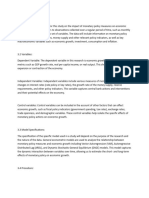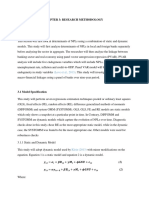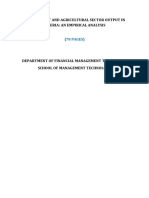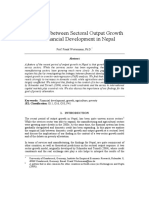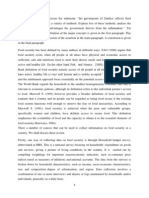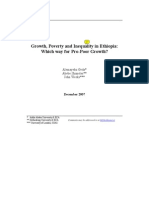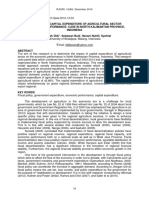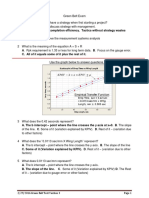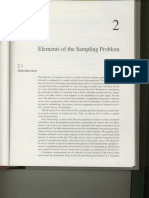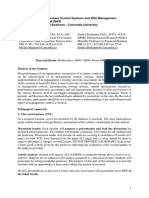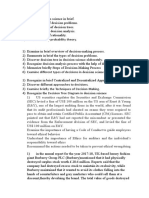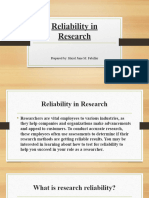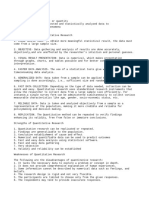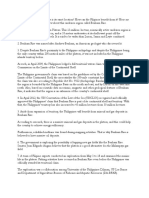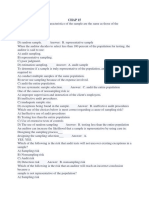CHAPTER THREE
METHODOLOGY
3.1 Introduction
This chapter outlines the methodological framework used to investigate the impact of Deposit
Money Banks (DMBs) on the Agricultural Sector in Nigeria. It encompasses data sources,
sampling techniques, variable measurements, model specification, and the estimation technique
employed.
3.2 Sources and Types of Data
The study utilizes annual time series data spanning from 1980 to 2022. Data on the dependent
variable, agricultural output (AO), was sourced from the National Bureau of Statistics (NBS,
2023) agricultural reports. However, the data for independent variables, including deposit
money bank credit (DMC) and deposit money bank interests (DMI), was obtained from the
Central Bank of Nigeria (CBN, 2023) statistical bulletin. Finally, data on government
expenditure was also obtained from the National Bureau of Statistics (NBS, 2023) database.
The selection of these specific data sources was guided by the principle of credibility and
accessibility. Both the National Bureau of Statistics and the Central Bank of Nigeria are
renowned governmental institutions in Nigeria, recognized for their meticulous data collection
practices and adherence to rigorous statistical methodologies. Furthermore, utilizing official
publications and databases ensured the data's accuracy and consistency.
1
�3.3 Sample Size and Sampling Technique
This research employs all available data for the period 1980-2022, resulting in a sample size of
43 observations. This approach ensures the capture of the maximum information available and
avoids potential biases associated with smaller sample sizes (Gujarati & Porter, 2009). By
employing a comprehensive data collection strategy and a robust sample size, this research
endeavored to establish a solid foundation for a rigorous analysis of the factors influencing
3.4 Variables Measurement
Table 3.1 Variables Measurement and Definition
S/N Variable name Level Type Measurement Data source
1. Agricultural AO Dependent Measured as the real National
Output value of agricultural Bureau of
production at constant Statistics
prices (e.g., base year (NBS, 2023)
2010) database.
2. Deposit Money DMC Independent Measured as the total Central Bank
Banks Credit credit extended by of Nigeria
deposit money banks to (CBN, 2023)
the agricultural sector statistical
bulletin
3. Deposit Money DMI Independent Measured as the Central Bank
Banks Interests average interest rate of Nigeria
charged by deposit (CBN, 2023)
money banks on loans statistical
to the agricultural bulletin
sector
4. Government GE Independent Measured as the total National
Expenditure government Bureau of
expenditure on Statistics
agriculture (NBS, 2023)
data base
Source: Authors computation, 2024
2
�Table 3.1 above presents and explains the variables employed in this study by specifying the
variable's name, description, and measurement. However, to justify the choice of these variables
as they relate to the study, the following discussion is immensely important.
Agricultural Output (AO): This variable is chosen as the dependent variable in all three
research questions outlined in chapter one of this study. The variable directly addresses the
study's focus on the impact of various factors on agricultural production in Nigeria. Agricultural
output serves as a quantifiable measure of the sector's performance, allowing for the assessment
of various interventions' impact on production levels.
Deposit Money Banks Credit (DMC): This variable is included in research question (i) to
examine its potential influence on agricultural output. This selection is supported by numerous
empirical studies demonstrating a positive relationship between financial inclusion and
agricultural development. Studies by Magaji et al. (2023), Asukwo et al. (2020), Chris et al.
(2016), Udoka et al. (2016), Ogbuabor & Nwosu (2017), Oyelade (2019), Ebere et al. (2021),
Onuegbu et al. (2022), Florence & Nathan (2020), Okafor (2020), George-Anokwuru (2018),
Olu et al. (2023), and Azike et al. (2020) consistently report a positive and significant impact of
bank credit on agricultural output in various contexts. Increased access to credit through bank
loans empowers farmers to invest in crucial inputs, equipment, and technology, potentially
leading to enhanced productivity and, consequently, higher output.
Deposit Money Banks Interest Rate (DMI): This variable is included in research question (ii)
to analyze its impact on agricultural output. This selection is grounded in the understanding that
higher interest rates can discourage farmers from seeking loans, thereby limiting their investment
capacity and potentially hindering output growth. This rationale is supported by research on
3
�access to finance and agricultural productivity, as evidenced in studies by Chris et al. (2016),
Oyelade (2019), and Azike et al. (2020). These studies highlight the negative, albeit sometimes
insignificant, impact of interest rates on agricultural output, suggesting that higher borrowing
costs can act as a barrier to investment and production growth.
Government Expenditure on Agriculture (GE): This variable is included in research question
(iii) to assess the influence of government policies on Agricultural output. This choice is justified
by the potential impact of government spending on various initiatives, such as infrastructure
development, extension services, and subsidies, on agricultural production levels. The relevance
of this variable is further supported by existing literature on government policies and agricultural
development, as demonstrated in studies by Chris et al. (2016), Ebere et al. (2021), Adofu
(2012), and Iganiga & Unemhilin (2011). These studies consistently report a positive relationship
between government expenditure on agriculture and output, suggesting that targeted investments
can stimulate production growth and enhance the sector's performance.
3.5 Model Specification
The following econometric model is specified to analyze the impact of Deposit Money Banks on
the Agricultural Sector in Nigeria:
AO = α + β₁DMC + β₂DMI + β₃GE + ε…………………………………………………… (3.1)
Where:
AO = Agricultural Output and it also stands as a proxy variable for the agricultural sector in
Nigeria
DMC = Deposit Money Banks Credit
DMI = Deposit Money Banks Interests
4
�GE = Government Expenditure
α = Constant term
β₁ = Coefficient of Deposit Money Banks Credit
β₂ = Coefficient of Deposit Money Banks Interests
β₃ = Coefficient of Government Expenditure
ε = Error term
This model assumes a linear relationship between the dependent and independent variables.
3.6 Estimation Technique
The Ordinary Least Squares (OLS) method will be employed to estimate the parameters of the
specified model. The choice of Ordinary Least Squares (OLS) as the estimation technique for
this analysis is based on several key factors. Firstly, the specified model posits a linear
relationship between the dependent and independent variables. This aligns perfectly with the
core assumption of OLS, making it the most suitable method for capturing the hypothesized
relationships (Greene, 2008). Secondly, OLS estimates offer a significant advantage in terms of
interpretability. The coefficients obtained through OLS directly represent the average change in
the dependent variable associated with a one-unit change in the corresponding independent
variable, holding all other factors constant. This straightforward interpretation facilitates clear
economic analysis and allows for the formulation of well-defined policy recommendations based
on the estimated effects (Wooldridge, 2010).
Finally, under specific assumptions, OLS boasts desirable statistical properties. These include
unbiasedness, consistency, and efficiency. Unbiasedness ensures that the expected value of the
estimated coefficients accurately reflects the true population parameters, leading to reliable
5
�estimates on average. Consistency guarantees that as the sample size increases, the OLS
estimates converge toward the true population parameters, providing increasingly accurate
results with larger datasets (Stock & Watson, 2018). Lastly, efficiency implies that among all
linear unbiased estimators, OLS minimizes the variance of the estimates, resulting in the most
precise estimates achievable under the given assumptions.
However, before proceeding with estimation, several diagnostic tests will be conducted to ensure
the validity of the OLS results.
3.6.1 Unit Root Test:
Unit root tests, such as the Augmented Dickey-Fuller (ADF) or Phillips-Perron (PP) tests, will be
conducted to determine the stationarity of the variables. Non-stationary variables can lead to
spurious regressions. According to Oyeni, (2012), "a spurious regression occurs when a non-
stationary time series variable is regressed on one or more non-stationary time series variable(s)
which makes such results invalid and therefore cannot be used for forecasting". Therefore, this
study will adopt the Augmented Dickey fuller (ADF) unit root test to verify the unit property of
the series. All the variables in the models will be subjected to the ADF test. The Augmented
Dickey fuller (ADF) unit root test is specified as follows:
yt 01 yt1iyt1t …………………………………………………….……. (2)
Where ∆ yt is the variation in у at period t, α0 represents constant, yt-1 is the past value of у, α1
is the estimated lag coefficients and µt is the error terms. The existence of unit root can be
determined through the following hypotheses: Null hypothesis is defined as H 0: = 0 (series have
unit root). The alternative hypothesis is given as H1: < 0 (series variables are stationary or series
does not have unit roots).
6
�3.6.2 Test for Serial Correlation:
The presence of serial correlation in the residuals can lead to inefficient and biased estimates.
The Breusch-Godfrey LM test will be employed to detect and correct for serial correlation, if
necessary (Breusch, 1979).
3.6.4 Normality Test:
The Jarque-Bera test will be used to assess the normality of the error term. While not strictly
necessary for OLS estimation, normality can improve the efficiency of the estimates (Jarque &
Bera, 1980).
3.6.5 Stability Test:
The CUSUM and CUSUMQ tests will be conducted to assess the stability of the estimated
coefficients over the sample period. This helps ensure the reliability of the model's results
(Cumby & Obstfeld, 1994).
By employing these diagnostic tests and addressing any potential issues, the research aims to
ensure the robustness and reliability of the estimated results and draw meaningful conclusions
about the impact of DMBs on agricultural output in Nigeria.
















